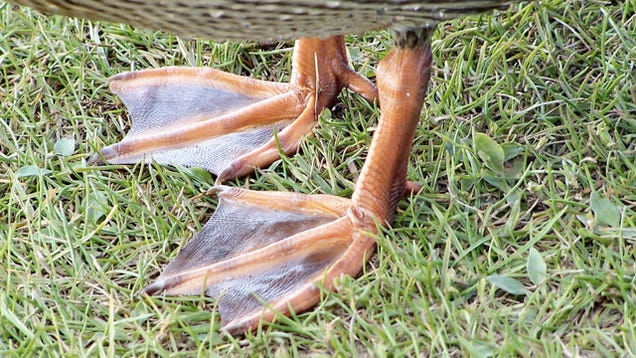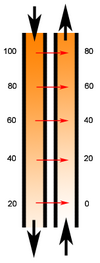The other day I was walking in a park near my house. This park has a pond with a fountain to keep the water aerated, which in the cold weather also keeps it from freezing as quickly as it might otherwise. Ducks love to hang out in & around this pond -- mallards, mostly, but also those larger, darker-feathered ducks, and Canada geese (note: Canada, not Canadian).
It was a super-cold day, probably about 21 degrees. I was all huddled up in my winter coat & scarf & gloves & hat, and there were the ducks, paddling around in the freezy-cold water, not a single coat or hat or glove on 'em. Some were standing along the shoreline, a few with one foot tucked up in their feathers, but most of them had both feet on the icy ground.

Ducks standing on the ice, letting the freezing-cold water lap over their toes, paddling in that frigid water -- no problem. If you're a duck.
(Photo from Eco Habits)
I have seen this for how many winters now? But this time around, it struck me: those ducks have nothing on their feet. No feathers, no insulating fat, no socks, no sheepskin-lined boots, no nothing. And they're paddling their naked orange feet in that freezing cold water like it's no big deal.
How can they do this without those little flappy orange feet freezing?
Answer: Duck feet are marvels of bioengineering, exemplifying the principles of heat exchange.

Duck feet. Simple genius.
(Photo from io9.com)

The intermeshing of arterial & venous blood vessels is called "retia" which means "wonderful net." The large panel in the third row on the left of this cartoon depicts retia.
(Cartoon from sci-ence.org)

The warm fluid on the left could represent the warmer arterial blood descending down to the duck's toes. The cooler fluid on the right could be the cooler venous blood going back up the duck feet to the heart. The proximity of the two results in the arterial blood cooling as it descends while the venous blood is warmed up.
(Diagram from Wikipedia)

(Photo from CopyPasteRepost)
P.S. Lots of animals use this principle of countercurrent exchange: most species of waterfowl have it in their feet, whales and sea turtles and other deep sea dwellers use it in their flippers, and cold-dwelling mammals such as arctic foxes and polar bears use this in their feet, too. Fish also use this principle, not to stay warm but to transfer oxygenated water from their gills to their blood. Desert animals such as kangaroo rats and salt-water-dwellers like seagulls use this principle in their nostrils to conserve fresh water. We also use this principle in our kidneys to remove water and build up urine, which we then get rid of as necessary.
Sources
Ask a Naturalist, Why Don't Ducks' Feet Freeze?
Beyond Penguins and Polar Bears, How Do Birds Stay Warm?
Bird Watcher's General Store, Duck Feet Do Not Freeze
Dandy Designs, Duck Feet
The Naked Scientists, Why don't ducks get hypothermia?
Encyclopedia of Earth, Counter current exchange
It was a super-cold day, probably about 21 degrees. I was all huddled up in my winter coat & scarf & gloves & hat, and there were the ducks, paddling around in the freezy-cold water, not a single coat or hat or glove on 'em. Some were standing along the shoreline, a few with one foot tucked up in their feathers, but most of them had both feet on the icy ground.

Ducks standing on the ice, letting the freezing-cold water lap over their toes, paddling in that frigid water -- no problem. If you're a duck.
(Photo from Eco Habits)
I have seen this for how many winters now? But this time around, it struck me: those ducks have nothing on their feet. No feathers, no insulating fat, no socks, no sheepskin-lined boots, no nothing. And they're paddling their naked orange feet in that freezing cold water like it's no big deal.
How can they do this without those little flappy orange feet freezing?
Answer: Duck feet are marvels of bioengineering, exemplifying the principles of heat exchange.

Duck feet. Simple genius.
(Photo from io9.com)
- It's true. Duck feet have no extra insulation, no waterproofed feathers, no extra layer of fat. If their bodies worked as ours do, which decrease blood flow to the extremities when it gets cold, ducks would be up a creek in a hurry.
- Fortunately for them, duck anatomy is not like human anatomy. Their bodies are equipped with special capabilities that ours are not.
- First of all, the innards of duck feet are almost entirely tendons. There's very little musculature, or much of any fleshy stuff at all. They're pretty much all skin, bone, & tendon. So there isn't much stuff in there that has to be kept warm.
- Oh, right, there's something else in their feet: blood vessels. Arteries & veins. You will remember from your biology class that arteries carry fresh, warm, oxygenated blood from the heart to all the parts of the body, and veins carry the used, cooler, less oxygenated blood back to the heart for rejuvenation. Ducks have arteries & veins just like we do, only they have a whole mess of 'em in their feet.

The intermeshing of arterial & venous blood vessels is called "retia" which means "wonderful net." The large panel in the third row on the left of this cartoon depicts retia.
(Cartoon from sci-ence.org)
- Specifically, the arteries & veins in ducks' feet are so closely intermeshed, their many arterial capillaries are cozied up close to their equally multitudinous venous capillaries. This artery-vein closeness is happening all down their legs & throughout their flappy feet.
- The reason this is important is because of that engineering phrase I used earlier: heat exchange.
- The simplest way to describe heat exchange is to say that if you put a warm thing next to a cold thing, the warm thing will heat up the cold thing.
- For example: your feet are cold, so you put them on the much warmer feet of your spouse/partner/best friend/dog, and though your sig. oth. may shriek at first, eventually, some of the heat from the sig. other's body will transfer to yours, and your feet will warm up.
- There is a kind of heat exchange particular to fluids, which is called countercurrent exchange. The same principle of heat exchange applies, in that the warm thing next to the cold thing transfers some of its warm to the cold thing. The main difference in countercurrent exchange is that it's all about fluids.
- (I wanted you to have these big science words mainly so you could say to people at parties, "Did you know, ducks keep their feet warm using the principle of countercurrent exchange?")

The warm fluid on the left could represent the warmer arterial blood descending down to the duck's toes. The cooler fluid on the right could be the cooler venous blood going back up the duck feet to the heart. The proximity of the two results in the arterial blood cooling as it descends while the venous blood is warmed up.
(Diagram from Wikipedia)
- That intermeshing of multitudinous arterial & venous capillaries means the duck's blood vessels are really making the most of countercurrent exchange, letting it happen as much as possible throughout the duck's legs & feet.
- While some of the heat from the arterial blood is transferred to the venous blood, the venous blood also cools the arterial blood on its way down.
- The result is that while the body of the duck may be around 100+ degrees Fahrenheit, thanks to its layers of fat & downy feathers, their feet will be pretty dang cold: only slightly above freezing.
- But that's warm enough, and the ducks are fine with that.

(Photo from CopyPasteRepost)
P.S. Lots of animals use this principle of countercurrent exchange: most species of waterfowl have it in their feet, whales and sea turtles and other deep sea dwellers use it in their flippers, and cold-dwelling mammals such as arctic foxes and polar bears use this in their feet, too. Fish also use this principle, not to stay warm but to transfer oxygenated water from their gills to their blood. Desert animals such as kangaroo rats and salt-water-dwellers like seagulls use this principle in their nostrils to conserve fresh water. We also use this principle in our kidneys to remove water and build up urine, which we then get rid of as necessary.
Sources
Ask a Naturalist, Why Don't Ducks' Feet Freeze?
Beyond Penguins and Polar Bears, How Do Birds Stay Warm?
Bird Watcher's General Store, Duck Feet Do Not Freeze
Dandy Designs, Duck Feet
The Naked Scientists, Why don't ducks get hypothermia?
Encyclopedia of Earth, Counter current exchange
No comments:
Post a Comment
If you're a spammer, there's no point posting a comment. It will automatically get filtered out or deleted. Comments from real people, however, are always very welcome!